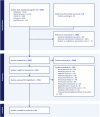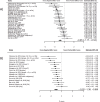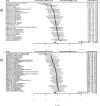Bone mineral density in childhood cancer survivors during and after oncological treatment: A systematic review and meta-analysis
- PMID: 40146277
- PMCID: PMC12089199
- DOI: 10.1007/s00198-025-07458-5
Bone mineral density in childhood cancer survivors during and after oncological treatment: A systematic review and meta-analysis
Abstract
Osteoporosis poses a significant concern for childhood cancer survivors (CCS). While recommendations for surveillance and management of bone mineral density (BMD) exist, no systematic review and meta-analysis has been undertaken to quantify BMD Z-scores in childhood cancer patients undergoing cancer treatment and survivors who have completed treatments. Accordingly, we conducted a systematic review with a 3-level mixed-effects meta-analysis to examine the course of BMD Z-scores in childhood cancer patients and survivors and identified possible moderators using meta-regression models. A systematic search was conducted in CINAHL, Embase, PubMed, SPORTDiscus, and Web of Science databases from inception to November 2023. We included studies that involved children and adolescents diagnosed with cancer before the age of 18 who were undergoing cancer treatment or had completed treatments and reported lumbar spine, hip/femoral neck, or total body BMD Z-scores derived from dual-energy x-ray absorptiometry. Forty-nine studies (4547 participants) were included in the meta-analysis. BMD Z-scores across different sites decreased with respect to baseline in children undergoing cancer treatment (mean difference: - 0.36, 95% CI - 0.62 to - 0.11; p = .01) and remained low following treatment in child and adolescent CCS (lumbar spine: - 0.85 SD, 95% CI - 1.17 to - 0.54; p < .001; hip/femoral neck: - 1.03 SD, 95% CI - 1.38 to - 0.68; p < .001), and adult CCS (lumbar spine: - 0.46 SD, 95% CI - 0.67 to - 0.26; p < .001; hip/femoral neck: - 0.36 SD, 95% CI - 0.57 to - 0.16; p < .001). Hip/femoral neck BMD Z-scores were moderated by age at assessment (p = .006), time from diagnosis (p = .004), sex (p = .037), and height (p = .026). Lumbar spine BMD Z-scores were moderated by age at assessment (p = .018), and sex (p = .015). In conclusion, childhood cancer patients and survivors experience reductions in BMD. Future research should evaluate the implications of regular physical activity, targeted exercise medicine, and nutrition therapy as first-line countermeasures to mitigate the declines in bone health.
Keywords: Bone mineral density; Childhood cancer; Dual-energy x-ray absorptiometry.
© 2025. The Author(s).
Conflict of interest statement
Declarations. Conflict of interest: Anna Maria Markarian, Robert U. Newton, Dennis R. Taaffe, Daniel A. Galvão, Jodie Cochrane Wilkie, Carolyn McIntyre, Francesco Bettariga, and Hao Luo declare that they have no conflicts of interest relevant to the content of this study.
Figures



References
-
- Miller KD, Nogueira L, Devasia T et al (2022) Cancer treatment and survivorship statistics, 2022. CA A Cancer J Clin 72:409–436 - PubMed
-
- van Atteveld JE, de Winter DT, Pluimakers VG et al (2023) Risk and determinants of low and very low bone mineral density and fractures in a national cohort of Dutch adult childhood cancer survivors (DCCSS-LATER): a cross-sectional study. Lancet Diabetes Endocrinol 11:21–32 - PubMed
-
- Morales JS, Valenzuela PL, Rincón-Castanedo C, Santos-Lozano A, Fiuza-Luces C, Lucia A (2019) Is health status impaired in childhood cancer survivors? A systematic review and meta-analysis. Crit Rev Oncol Hematol 142:94–118 - PubMed
Publication types
MeSH terms
LinkOut - more resources
Full Text Sources
Medical

